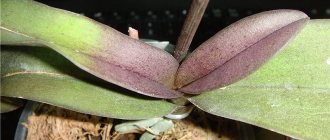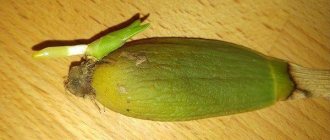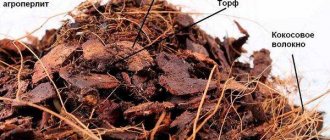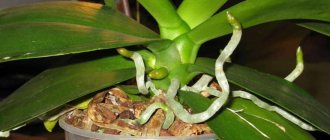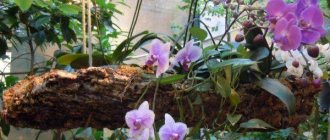Orchids are beautiful flowers that delight gardeners with their beauty and long-lasting flowering. Representatives of this family are beautiful all year round. Proper care ensures their health and development. Different types of orchids require different care. There are species that can be considered capricious, and there are also unpretentious beauties. Unfortunately, it is not always possible to preserve the health and beauty of a flower. The leaves of the plant may lose their elasticity and color saturation.
This article will discuss how to restore leaf turgor in an orchid.
What is turgor?
First, it’s worth understanding what leaf turgor is and what is included in this concept.
The explanation is simple; turgor is usually called the normal state of a leaf , in which it is dense, elastic, and brightly colored.
This is especially important for phalaenopsis; the characteristics of the leaf determine the well-being of the entire plant.
The normal state of an orchid leaf plate has the following characteristics:
- The leaf is erect;
- Dense;
- Has a light waxy coating;
- It is characterized by elasticity.
Such leaves indicate that the indoor pet receives a sufficient amount of moisture, feeding and care for it is ideal.
Important! The first evidence that mistakes are being made in caring for phalaenopsis will be changes in the condition of the foliage.
Normal turgor of phalaenopsis orchid leaves.
It is the ground part that will quickly respond to an insufficient amount of moisture or its abundance.
Leaf turgor appears:
- Withered leaf blades;
- Wrinkling;
- Changing color.
If the process worsens, the flower may even shed its leaf, regardless of its age and location.
There are many reasons for the loss of leaf turgor in phalaenopsis, and depending on this, different ways to eliminate it are selected.
Causes of lethargy
limp for various reasons, most of which will be closely related to caring for the trunk.
As you know, orchids in pots are quite finicky plants. In order for them to grow and develop normally, you should take all recommendations and requirements seriously.
Possible reasons why the leaves have lost turgor:
- If the roots die , as a result the plant does not receive enough moisture, the leaves especially suffer from this. Due to low water content, they begin to wilt, wrinkle and turn yellow;
- The natural aging process is the same. The trunk leaf lives for about 2-3 years, and then dies, before which it wilts;
- Overheating or frostbite have the same effect on leaf blades. They wither from too high or too low temperatures;
- Poor watering will cause the leaves to wilt. In addition, the development of the peduncle may stall, or it may simply dry out;
- Incorrectly selected fertilizing will have a detrimental effect on the condition of the foliage, and a high concentration of nutrients during watering will have the same effect. Therefore, you must strictly follow the recommendations on the packaging;
- Deterioration of turgor may be a signal from the plant about the presence of a disease or pests . If you do not react in time, you can lose the entire standard.
If the roots die, the plant loses leaf turgor.
But don’t despair if your pet’s foliage has lost its elasticity.
The orchid can be restored , but you should remember that to do this you will need to be patient and establish the cause of the turgor.
What vitamins to take for skin rejuvenation
The following vitamins have a good effect on the condition of the skin:
- Vitamin A, or retinol. This component helps to compact the top layer of the skin; accordingly, it retains moisture and prevents various types of damage. Vitamin A is found in fish, eggs, as well as vegetables and fruits.
- Vitamin E, or tocopherol. It is this substance that promotes rejuvenation of the skin, gives elasticity to the epithelium and tones muscle tissue. Vitamin E is found in nuts, seeds and vegetable oils.
- All B vitamins. These substances are indispensable for the body as a whole. They ensure normal metabolism and participate in the redox processes of the skin. B vitamins are found in cereals and dairy products, legumes and fish.
- A nicotinic acid. This substance penetrates cells and regulates all metabolic processes at the micro level. It is found in meat products, yeast, as well as potatoes, beans and buckwheat porridge.
Include these foods in your diet to ensure youthful skin and prevent premature aging.
How to restore leaf turgor in a phalaenopsis orchid?
There are several ways to restore turgor to the leaves of a plant. Each will be effective only for certain causes of wilting.
Important! Be sure to establish the cause of lethargy, and only then begin to correct mistakes in care.
Turgor can be rehabilitated:
- Vitamin cocktail, which is prepared as a top dressing for the trunk. This method is used only for those orchids in which leaf lethargy has begun due to insufficient watering and a minimum amount of fertilizer applied. The flower simply withered away.
If there is insufficient moisture, the pot with the plant is lowered into a container with a vitamin cocktail.per liter of water , dissolve it in warm water and lower the pot into the container for 2-3 hours. If the plant has been withering for a long time, then restoration procedures with a cocktail are carried out daily for a week, and soaking should not last more than half an hour. Such restoration can be carried out using an orchidarium or a simple package. The stem is immersed in the container and hung upside down;
- Glucose will help restore elasticity . To do this, prepare a syrup from 3-4 tsp. sugar and a glass of water. This solution is applied daily to the outside of the leaf, and must be washed off in the morning. The procedure will help reduce moisture loss from the leaves and turgor will return to normal over time. Sugar syrup is usually used for 3-4 days, then take a break for several days. Recovery usually occurs after three procedures; in complex cases it may take longer;
- Spraying helps when the plant overheats ; water with a small amount of fertilizer is taken into the spray bottle. Spraying is usually carried out in the morning and at lunchtime, so that before dark the plant can completely absorb nutrients and dry out from excess moisture. With this method of rehabilitation, it is advisable to place the flower in a basket and hang it, this way it will be possible to avoid rotting of the roots. This method will also be effective when the rhizome dies due to disease or pest;
- Restore turgor of phalaenopsis leaves after drying out You can simply soak the roots. To do this, the plant is removed from the substrate, the roots are thoroughly washed, and pieces of adhering soil are removed. Then fill the container with water at 30-35 degrees and lower the roots there. Soaking can last up to 6 hours at a time, but do not overdo it. It is better to carry out the procedure for several days in a row, but keep the plant for no more than 2 hours;
Rinsing the orchid roots for further soaking.
Important! Carrying out such a procedure for roots with rot is strictly prohibited; this can aggravate the condition of the plant or even destroy it.
- Biostimulants Epin and Zircon are also effective . Their use will help restore or increase the roots and green mass of almost any plant in the shortest possible time. Resuscitation of phalaenopsis is often carried out with the help of these drugs; the important point is that they can be used for rot on the roots. The product contains fungicidal substances that fight fungi and putrefactive bacteria.
The remedies will help the plant cope with any stressful situation and get out of it with minimal losses.
The consequences of frostbite or overheating will go away much faster, the trunk will begin to actively recover and develop;
- Returns turgor to phalaenopsis leaves foliar feeding. It is used in cases where the roots are severely damaged or the trunk needs to be restored in a short time. Nutrients in liquid form are applied to the leaf plates, through which they quickly penetrate inside and actively begin to support the leaves of the flower. If the damage is minor, results will become visible within a couple of hours after application.
Turgor will be restored to phalaenopsis leaves by foliar feeding.
Important! It is impossible to use root and foliar feeding at the same time. It's better to do this one at a time.
These methods, in combination or separately, will eliminate wilting, the leaves will become elastic and dense again.
Salon procedures that increase skin elasticity: TOP 5 best
After visiting a beauty salon, we usually feel renewed and rejuvenated. How can you increase the elasticity of your facial skin
using cosmetic procedures, and which of them are most effective?
Photolifting
It is a process aimed at rejuvenating the epidermis. This is a facelift using special radiation, which has a beneficial effect on the general condition, stimulates the production of melanin and collagen. As a result of this event, softness and elasticity returns to the skin, and turgor increases.
Ozone therapy
A procedure whose effectiveness has long been proven by specialists and consumers, thanks to which it is actively gaining popularity. Helps smooth out wrinkles, prevents the occurrence of pimples and acne, and effectively fights a number of diseases. After several procedures, the skin acquires a healthy appearance. As necessary, ozone therapy is carried out on any problem area.
Mesotherapy
It is one of the most intensive and effective methods aimed at rejuvenating and improving skin condition. However, it is important to consider the fact that its exposure damages the epidermis. A certain composition is injected under the skin, accelerating metabolism and normalizing the general condition. After this, wrinkles are smoothed out, appearance significantly improves, pores narrow, pimples, age spots and other manifestations of diseases disappear. In more mature women, the face acquires a clear oval. Be prepared for the fact that this procedure is very painful.
Myostimulation
One of the most useful methods for improving the condition of the face and body is myostimulation. The peculiarity of the procedure is that microcurrents are passed through the skin, as a result of which they regain a healthy glow, softness and elasticity, wrinkles are smoothed out, the facial contour is tightened, and swelling and puffiness also disappear. However, if you have recently had injections of hyaluronic acid or Botox, then it is better to avoid this procedure for now.
Prevention
It is better to prevent any disease than to treat it. The same applies to restoration procedures for turgor of phalaenopsis leaves.
In order not to waste a lot of time and effort on putting the trunk in order, you just need to care of it responsibly
- Water in a timely manner;
- Fertilize moderately;
- Do not allow water to stagnate in the pot and tray;
- Change the substrate regularly;
- Maintain the required humidity and temperature conditions;
- Do not allow the flower to overheat, much less frostbite.
For prevention purposes, it will also be effective to regularly spray the trunk and water it with a warm shower.
Important ! When carrying out such procedures, it is worth removing moisture from the growing point; accumulated water can cause rotting of the trunk.
Adviсe
Sometimes non-standard situations for which it is impossible to apply general recommendations. In such cases, it is worth looking for another way out.
The turgor of an orchid’s leaves may also disappear during the period of resuscitation of the entire stem, so what to do here:
- Leaf turgor for a rootless is restored by immersing a small piece of the trunk in water for several days. This must be done extremely carefully and carefully monitor the reaction;
- A less risky method is to install a stem above the surface of the water in which nutrients are diluted. This method will help restore leaves and grow roots in the shortest possible time;
- During the flowering period, an orchid can also lose leaf turgor. During this period, it is worth paying attention to watering; it must be timely and sufficient. It would be good to “bathe” the trunk under a warm shower and water it using the immersion method with a minimum concentration of fertilizer;
- Sometimes, on the third day after watering, phalaenopsis leaf turgor worsens. The reason for this is usually an insufficient number of roots, which are not able to provide the entire trunk with moisture and nutrients. To improve the situation, you should grow a sufficient number of roots using stimulants or remove a couple of lower leaves.
Sometimes after watering on the third day the turgor worsens.
Important! You can remove leaf plates only if there are more than six of them near the trunk.
There are other difficult situations in which you should not do it yourself, but consult with more experienced flower growers or visit a flower shop.
Sellers are usually more knowledgeable about this issue than novice gardeners and will be able to give good advice.
The growing point has turned black and the leaves have withered
Of particular concern to gardeners is damage to the growing point of monopodial orchids, since it is found in only one specimen.
Its blackening is usually caused by physical damage, burning in the bright sun, bacterial or fungal infections, or water entering and remaining in the core for a long time.
The result depends on the degree of damage and the chances of salvation are 50/50.
After damage to the growing point, the leaves will naturally begin to wither due to the blocking of food access. The “rosette” will not grow, and the orchid may begin to multiply, that is, form children from meristems located on the peduncle or meristems on the stem.
Sooner or later they will grow, especially if they are helped in this by using hormonal cytokinin paste.
This option of rescue, with the subsequent separation of the baby, has a chance of existence if there is a dormant kidney or kidneys. Otherwise, the leaves may remain limp for some time, but will gradually begin to turn yellow and eventually dry out completely.
If at least a small part of living tissue remains at the growth point, then the orchid can be reanimated. True, it will take too long to fully restore it.

